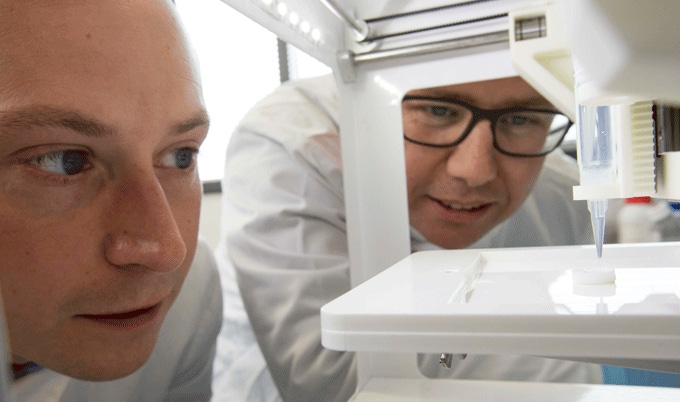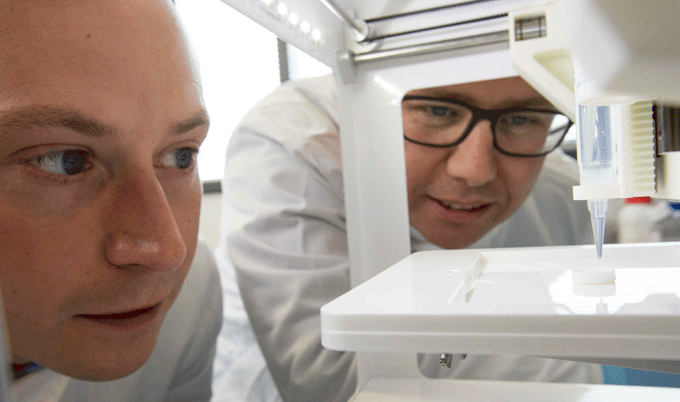Researchers Achieve First 3D Printing of Human Corneas
A team has successfully 3D-printed the first human corneas for transplant using seaweed-based bio-ink.
July 12, 2018

Researchers in the United Kingdom have achieved the first 3D printing of human corneas that can potentially be used in replacement surgeries. In doing so, they have paved the way for an unlimited and easy-to-fabricate supply of new corneas to patients that need them, they said.
Key to the achievement by scientists at Newcastle University is a novel bio-ink—a gel comprised of alginate, a polysaccharide derived from seaweed, and collagen, the main structural protein in cornea. The ink met three key criteria necessary for the fabrication of corneas, Che Connon, professor of tissue engineering at the university, told Design News. In addition to keeping stem cells alive to create a living cornea, it produces a material stiff enough to hold its shape, yet soft enough to be squeezed out the nozzle of a 3D printer.
“The combination helped the gel do the things it needs to do,” Connon said. “What we’ve done is, for the first time, demonstrated that images taken from a person’s cornea can be rendered in a 3D model on a computer and then that can be recreated in a dish using a 3D-bioprinting system.”
|
University of Newcastle researchers Dr. Steve Swioklo (left) and Professor Che Connon watch as a cornea is bio-printed. The two developed a process and printer for fabricating the first 3D-printed corneas for transplant surgeries. (Image source: Newcastle University) |
Cornea transplants can give people back their sight after they’ve lost it due to corneal blindness, which can happen due to burns to the corneas, serious infections, or other afflictions.
While many countries in the first world have large cornea banks for transplant patients, many in under-developed regions of the world do not. Unfortunately, it’s usually in these places where people need cornea replacements the most, Connon said.
“Many people don’t have access to cornea transplantation in places where there are a lot more instances of burns and infections that can cause corneal blindness—so a higher incidence, but a lower availability of corneas,” he explained.
Even in the more developed world, eye banks are only just keeping up with demand due to a couple of factors, Connon said. Those are that people are living longer, and there has been a rise in refractive surgery—or surgery to correct people’s vision—in which case the corneas can’t be re-used later.
The Newcastle team has been studying corneas for 20 years. So it was well-informed to develop a viable 3D-printing process and the material needed to produce corneas that will work well for implants, Connon said.
One key aspect they had to consider to bio-print a viable artificial cornea is the shape of the cornea, he explained. “We previously showed last year that the shape of a tissue instructs the cells within it,” Connon said. “Any artificial cornea should not be flat, it should be curved, so the cells will behave in a more cornea-like way and create a more functional cornea.”
Connon worked chiefly with Dr. Steve Swioklo, a research associate in the university’s Institute of Genetic Medicine, on the research. He also collaborated with a company spun off from the university called Atelerix. That company provides a sealed tube for storing living cells for use in medical applications, he said, which could enable easy fabrication and replacement of corneas in patients.
|
“A doctor in surgery could have a 3D printer with the program and then reach up and take a printing gel from the shelf and plug right into the printer, separating the wet and messy production of cells from the production of printing,” Connon explained. “It’s a really powerful application moving forward.”
The research is still years away from being integrated into patient surgery and care. Yet it’s still an example of how 3D printing is changing the landscape for healthcare and demonstrates a promising development for patients who lose their sight to corneal afflictions in the future, Connon said.
“We’re seeing 3D printing in many avenues of our life,” he said. “In healthcare, it’s not just how quickly you can have something made, but also how you can make something bespoke. A cornea that has the right shape and size for a particular patient can now be done with a 3D-printing technique.”
The research team published a paper on its work in the Elsevier journal Experimental Eye Research.
Elizabeth Montalbano is a freelance writer who has written about technology and culture for 20 years. She has lived and worked as a professional journalist in Phoenix, San Francisco, and New York City. In her free time, she enjoys surfing, traveling, music, yoga, and cooking. She currently resides in a village on the southwest coast of Portugal.
RELATED ARTICLES:
About the Author(s)
You May Also Like





